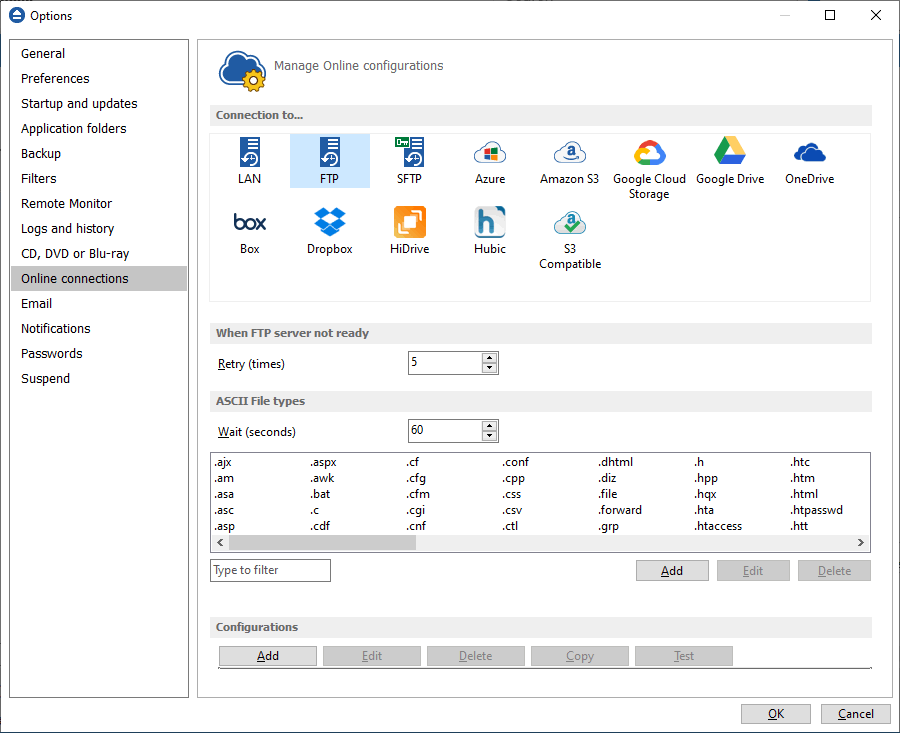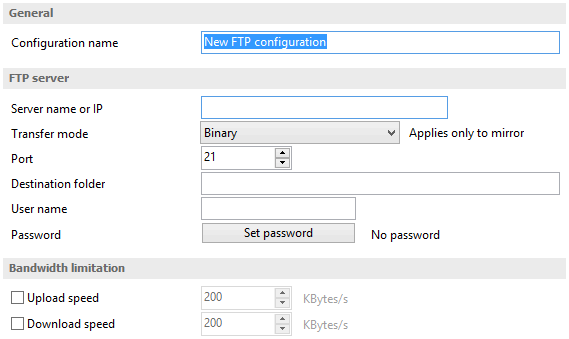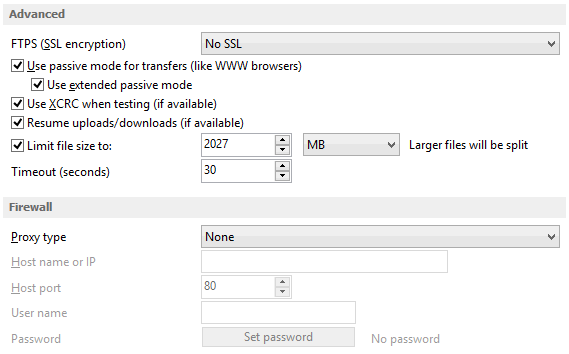The FTP page of the Options window (accessible from the File, Options->Online connections menu item) contains FTP settings.

When FTP server not ready
The first number (Retry option) indicates how many times the application tries to access the destination server if it is not available. By default this option is set to 5 attempts. The second number (wait option) indicates how many seconds to wait between two consecutive attempts to access the destination location. By default this option is set to 60 seconds. This option is useful when the destination FTP server has restrictions (i.e. only 2 users logged in the same time, no. of accesses etc.) and insures that if the FTP server cannot accept your connection, it will not be "hammered" by sending log-in requests frequently.
Configurations
The File->Options->Online connections->FTP window allows you to define FTP configurations that can be used on the Destination page in the New Backup Wizard or Backup Properties windows. You can add, edit, copy or delete an FTP connection using this window.
In order to add a new FTP connection press the Add button. The Define FTP configuration window will appear in the list and you can enter the other settings for this connection.

General
Configuration name
Enter here an arbitrary name for the connection. By default the New FTP configuration name is assigned.
FTP Server
Server name or IP
In this field you have to enter the name or IP address for the FTP server
Transfer mode - Here you can select the transfer mode: Binary, ASCII or Auto.
- Binary: it refers to transferring files as a binary stream of data. The binary mode transmits the raw bytes of the file being transferred. In this way, the file is transferred in its exact original form.
- ASCII: it stands for American Standard Code for Information Interchange, and is a type of character encoding based on the English language used on devices that handle information stored in text. It includes 33 non-printed control characters and 94 printed characters such as letters and punctuation.
- Auto: according to the list of ASCII files defined in File->Options->FTP, the files will be uploaded in ascii or binary mode, depending on their extension.
By default, binary mode is selected and it applies only to Mirror backup type. That is useful if you have a Linux FTP server as backup destination and want to download the backed up files with another application which uses the Auto transfer mode. Uploading the files to a Linux server in binary mode and downloading them in Auto mode, causes the files to be modified by adding a new empty line at the end of each file.
Port
In this field you have to enter the port number if different than the default FTP ports (21).
Destination folder
Here you can specify a destination folder on the remote FTP server where the backup will be stored. If the entered folder does not exist, it will be created on the server. If no destination folder is set, Backup4all will automatically create a folder using the name of the backup job.
User name
If this is a private FTP server (no anonymous access allowed) you have to enter the user name for your account.
Password
In this field you can enter the password for the FTP server. There are FTP servers that allow anonymous access (public FTP servers). You can connect to these types of FTP servers using as user name Anonymous and your email address as password. It is not recommended to backup important files to public FTP servers.
Bandwidth limitation
This section allows setting different limitations for upload/download speed:
- Upload speed - if checked you can set a maximum upload speed for the FTP transfer
- Download speed - if checked you can set a maximum upload speed for the FTP transfer

Advanced
FTPS (SSL encryption)
Indicates the level of Transport Layer Security (TLS) required for control channel and data channel connections to the FTP server:
- No SSL - the server does not require Secure Socket Layer transport
- Implicit SSL - implies that Secure Socket Layer is in use
- Only explicit SSL - allows the connection to the FTP server only if TLS is available.
- Explicit SSL, if available - when SSL is available, uses explicit security by default. The server allows regular FTP sessions without encryption as well as encrypted FTP sessions using SSL.
Use passive mode for transfers (like WWW browsers)
Each file transfer (upload or download) needs an additional connection for the data stream. Normally (in active mode), the server establishes this connection. In passive mode, however, the client establishes the connection. This may be necessary through some firewalls, which do not allow connections from outside.
Use extended passive mode
The FTP Server operates exactly the same as passive mode, however it only transmits the port number (not broken into high and low bytes) and Backup4all is to assume that it connects to the same IP address that was originally connected to. Use this option if the normal passive mode connection failed.
Use XCRC when testing (if available)
If the server supports the XCRC extension Backup4all can verify that files transferred to the server have been transmitted correctly using the CRC information received from the FTP server. This results in faster testing, as the files will not be downloaded to perform the CRC testing.
Resume upload/downloads (if available)
If this option is selected, the application will try to resume the backup upload, if the server supports resume command.
Limit file size to
Here you can specify the maximum size of the files to upload. Larger files will be split. Please note that many FTP servers does not allow you to upload files larger than 2 GB.
Timeout (seconds)
You can set the time interval (in seconds) that is allowed for no data transfer before the transfer operation is interrupted and must be resumed. Default is 30 seconds.
Firewall
Proxy type
Select one of the options below (supported by your firewall) if you use a proxy to connect to the FTP:
- None - Sends the User name and optional Password for the FTP server as entered in the FTP window
- Send command USER - Sends the User name and optional Password defined in the proxy settings, followed immediately by the User name and optional Password for the FTP server.
- Send command SITE - Sends the User name and optional Password defined in the proxy settings, the SITE command with the Host value, and the User name and optional Password for the FTP site.
- Send command OPEN - Sends the User name and optional Password defined in the proxy settings, sends the OPEN command with the Host value, and the User name and optional Password for the FTP site.
- USER user@firewalluser@hostname / PASS pass@firewallpass - Sends the command USER user@proxyuser@host, then the command PASS pwd@proxypwd, or optionally PASS pwd.
- Transparent - Sends the User name and optional Password defined in the proxy settings, followed immediately by the FTP server User name and optional Password.
Host name or IP
In this field you have to enter the host name or IP address for the proxy server (firewall).
Host port
Enter the host port number in this field. By default, the port number is set to 80.
User name
This field is used to enter the proxy user name.
Password
In this field you can enter the password for the specified user name.
ASCII file types
It includes the list of all file extensions that will be transfered as ASCII when using Auto transfer mode for FTP uploads. You can filter, add, edit or delete the file extensions listed here.
Please note: if you add non-ASCII file types in this list, when you back up such files in ASCII mode they will get corrupted and you won't be able to use them.


